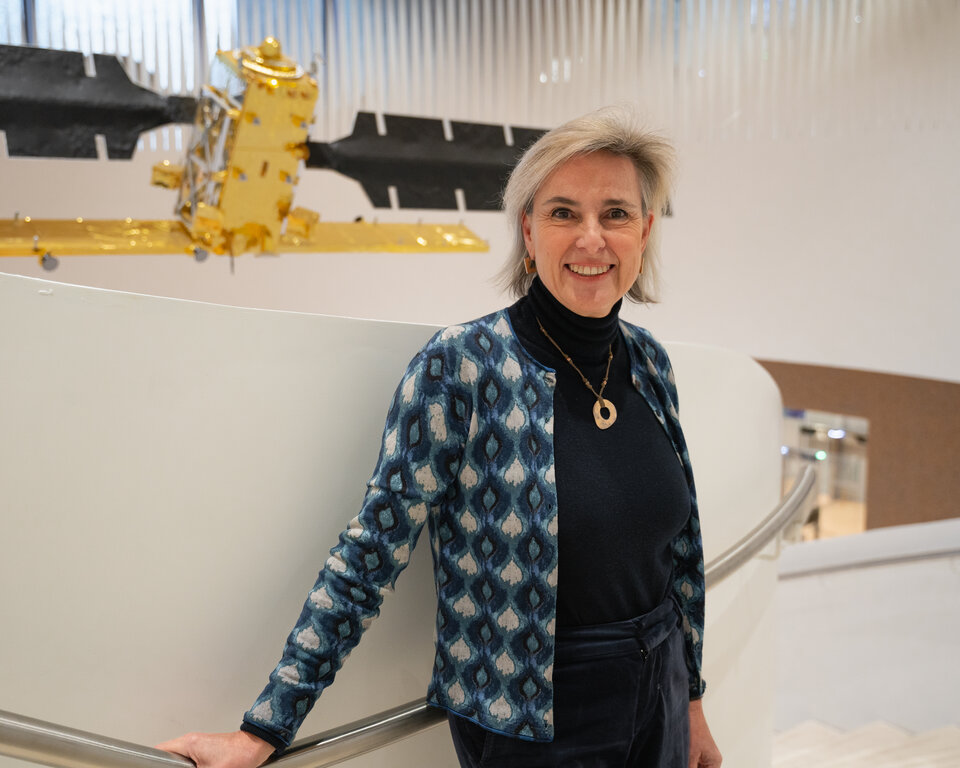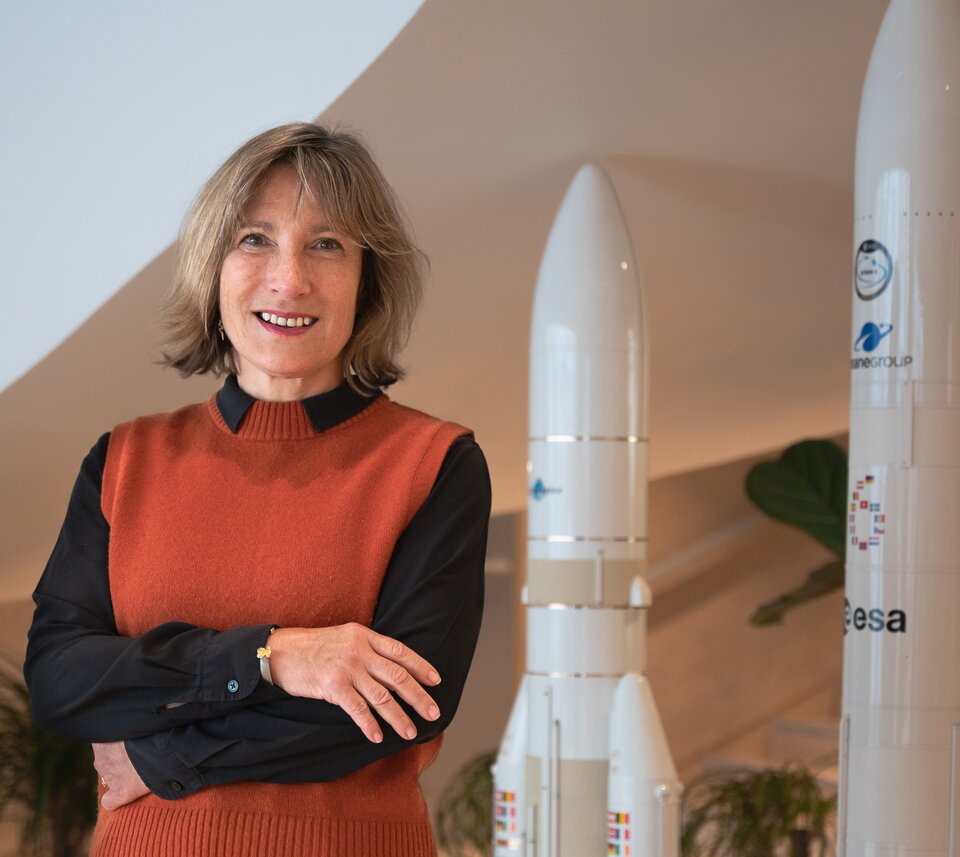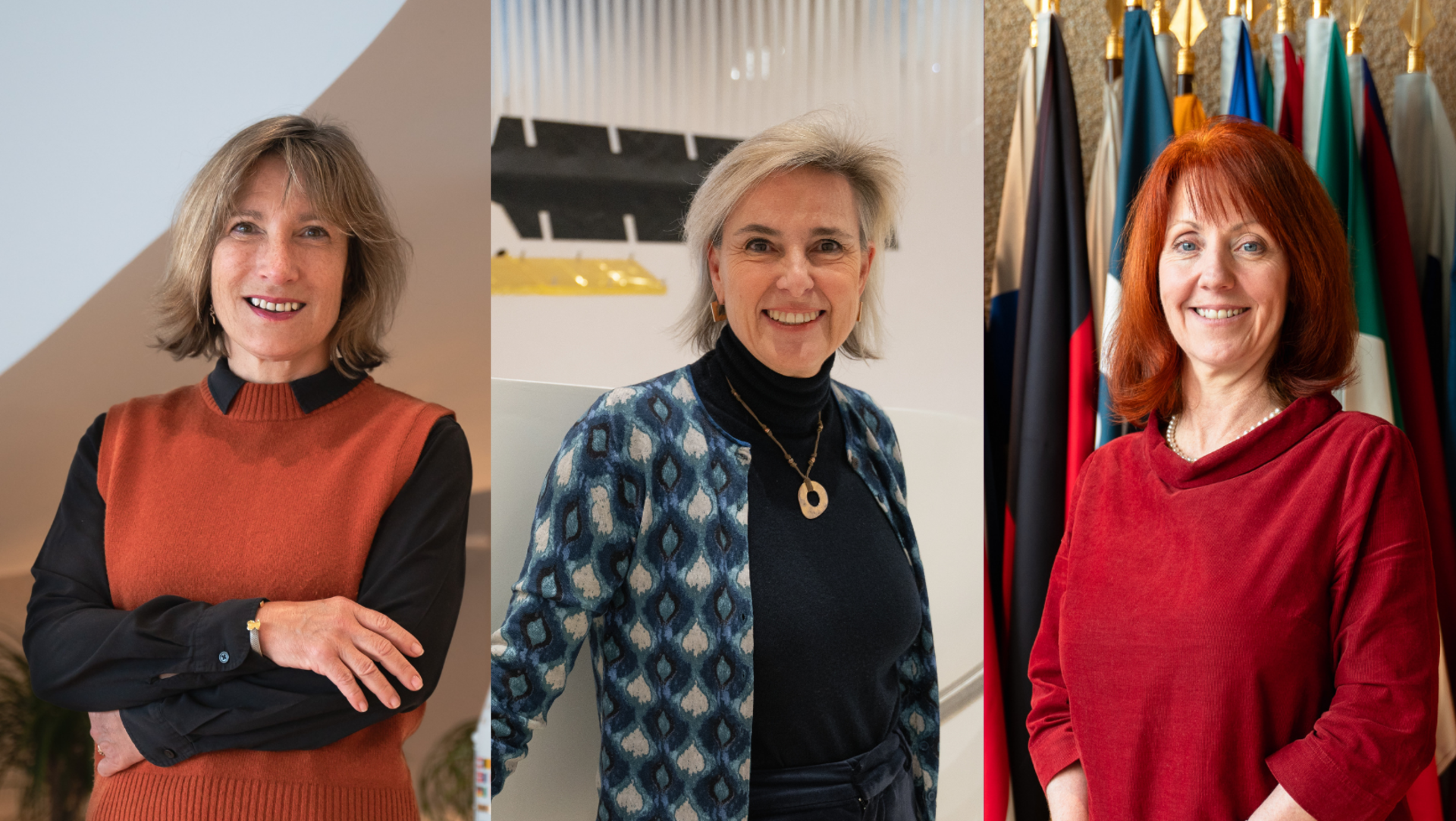Conversations with ESA Directors on International Women’s Day
For International Women's Day 2024, we're acknowledging the remarkable careers of the women in key Directorate positions at ESA: Simonetta Cheli, Geraldine Naja and Carole Mundell. Read about the impactful work, pivotal life experiences and their insights on fostering a more inclusive future.
International Women’s Day calls for action to break down barriers, debunk stereotypes, and create environments where women’s perspectives and contributions are valued and recognised. ESA remains committed to promoting gender balance in the workforce and creating an inclusive environment. A series of tangible initiatives have been implemented with the goal of supporting women at all organisational levels and encouraging girls to explore their interests in STEM subjects. In the last years, these measures have led to a growing number of women showing interest in space careers and a recruitment share for ESA jobs higher than the number of applications. This has resulted in a continuous rise in the proportion of women in the ESA workforce, currently standing at about 30 percent - and a very significantly increase of representation in top management positions, where women accounted for 20 percent of leadership roles in 2023.
For International Women’s Day, we talked with three inspiring women, each holding the role of Director at ESA: Simonetta Cheli, Geraldine Naja and Carole Mundell. Their stories offer inspiration and encouragement to young girls and women with a passion for space, auguring a promising future for gender equality within the space sector.
Simonetta Cheli

Q. Tell us more about your current duties as Director of Earth Observation Programmes
As Director of Earth Observation Programmes at ESA, I manage the development of operations and applications related to satellite missions and activities in the field of meteorology, climate change, environment and science missions. We currently have 15 Earth Observation missions in operation and about 40 in the development, jointly built with European industries. Part of my job is to make sure that once the satellites are launched, the data are distributed to the user and are well archived, and also that their value is demonstrated to those who use them for science and application projects. We take the pulse of our planet and not only does this tell us the state of environmental parameters, sea level rise, ice melting, deforestation and air quality, but we can also inject those data into models that are very important for scientists as well as for the decision makers who need to take informed decisions about the implementation of the regulation on Green Deal. I have staff in four different ESA sites and manage 30% of ESA’s total annual budget of €7 billion. I am also the Head of Establishment for ESA ESRIN in Frascati, Italy, and representative of ESA in Italy.
Q. Is there any particularly interesting project on which you're currently working?
There are many projects that we are currently working on as we have six satellites launches planned for this year, but we also have many science projects, we work on the climate variables in the climate context, we support new commercial initiatives in the field of Earth observation and a new initiative for developing a ‘Digital Twin’ of Earth. The latter is an extraordinary ambitious project, but one that is possible to achieve, especially by starting from the vast amount of data we collect every day from space. We will begin with various digital models of the planet, each dedicated to reproducing specific conditions. It is an overall very exciting and challenging work but that I manage with a great team and very motivated and experienced people, and this is very rewarding.
Q. Can you recall a life experience that has played a significant role in shaping the person you have become, and in what ways?
When I proposed to my university professor the idea of working on a thesis about the international law of telecommunication satellites, he challenged me, expressing scepticism about its feasibility. I embarked on a research journey at the United Nations in New York, to carry out my research at COMSAT, a satellite telecom operator. Eventually, I succeeded in getting the highest votes for my thesis. Later, my professor and I often joked about it. Not only did I find the topic of my research fascinating, but I also secured a job related to it that I truly enjoyed.
Q. Who is a woman for whom you have a lot of admiration?
I admire quite a few personalities, and a special one is Simone Veil. I met her when she was the President of the European Parliament in Brussels, and I always found her to be a rigorous, fascinating and inspiring woman due to her strong values and beliefs in international cooperation, human rights and peace.
Q. How can we, ESA, promote positive change with respect to gender equality?
ESA has shown a positive trend in recent years, demonstrating increased gender representation across all levels, including senior management positions. While it is essential to prioritise selecting the most qualified person for each role, there is a simultaneous need to encourage women and young girls to pursue careers in the STEM fields. ESA has undertaken numerous initiatives in this regard. By having gender balance in the selection boards, tender evaluation boards, and various governance activities, the organisation naturally fosters inclusiveness, promoting diversity as an integral part of its operations.
Carole Mundell

Q. Tell us about your role as Director of Science at ESA
I have the privilege to lead the ESA Science Directorate and, as such, I am also Head of Establishment at ESA’s European Space Astronomy Centre, near Madrid – the ESA home of science – and where I act as the Director General’s diplomatic representative in Spain. I have staff in five different countries, including the United States, and it is a leadership and management role that covers a very broad portfolio.
The Science Directorate collaborates with Member States and with our international partners to explore fundamental questions about the Universe. We achieve this by developing cutting-edge technologies for spacecraft missions that venture beyond Earth's orbit. Our missions range from studying neighbouring planets such as Mars and Venus to exploring distant stars, galaxies and black holes at the edge of the observable Universe. We also delve into the earliest moments of the Universe, probing space-time and the governing laws of physics. Our dynamic programme not only pioneers advancements in science and technology, but also facilitates technology transfer for future missions. Recognising the importance of data from our missions, we actively preserve and innovate in digital platforms, making legacy data valuable for future generations. By fostering engagement with scientists and citizens, we encourage innovative approaches, such as machine learning and artificial intelligence, to extract unforeseen insights from our mission data. The continuous evolution of our efforts reflects our commitment to ESA's role in addressing the STEM skills gap and maintaining European leadership in space exploration.
Q. Can you provide an overview of the current Science Programme strategy, Cosmic Vision, and its major milestones and missions?
The final missions of the Cosmic Visions programme encompass science from studies of the Solar System to gravitational waves. This year, we launched the L1 mission Juice to study the icy moons of Jupiter, the wider jovian system and to search for signatures of habitability in the liquid oceans we believe exist beneath the icy crusts. We also launched the incredible Euclid mission to study the ‘dark Universe’, to understand the nature of dark matter and dark energy by surveying one third of the sky back to 10 billion years ago with exquisite precision. Missions in development include Plato and Ariel, which will study exoplanets beyond our Solar System and, for the first time, give us unprecedented insights into the properties of exoplanet atmospheric chemistry! Comet Interceptor, to be launched in tandem with Ariel, will loiter in space for two to three years, then chase and study a comet – sounds almost like science fiction! And we are going through the mission adoption reviews at the moment for our ground-breaking Venus mission, Envision, and the three-spacecraft LISA mission which will enable us to probe ripples in space-time caused by the catastrophic merger of supermassive black holes – whilst pushing our spaceflight skills to the limit! In parallel, we are currently reviewing the viability of the ‘New Athena’ X-ray mission, which seeks to study high-energy radiation from very hot X-ray emitting plasmas in extreme places in the cosmos such as close to black holes and in massive galaxy clusters. This is just a flavour of the work led by our directorate.
Q. How do you see the transition from the current Cosmic Vision program to the upcoming Voyage 2050?
When planning Voyage 2050, we asked the science community for their ideas, and we got a lot of them! We carefully went through all these ideas and grouped them into three main themes for big missions: (1) Moons of the giant planets, (2) From temperate exoplanets to the Milky Way, and (3) New physical probes of the early Universe. Voyage 2050 also focuses on important new technologies for the next century, such as cold atom interferometry for atomic clock development, enabling X-ray interferometry for the future study of compact objects like black holes, and developments for future planetary missions: in particular better power sources to enable the exploration of the outer Solar System, and advances in collecting and storing cryogenic samples of cometary ices for the search for life in the outer Solar System.
Q. Can you recall a life experience that has played a significant role in shaping the person you have become, and in what ways?
Working as Chief Scientific Adviser in the UK Foreign, Commonwealth and Development Office (Foreign Ministry) was life changing. Seeing the real-world impact of robust, trustworthy science evidence and the power of international collaboration at a time of global crisis gives me hope in this conflicted world.
Q. Who is a woman for whom you have a lot of admiration?
There are many women and men from whom I have learned and taken inspiration – and continue to do so. I have been particularly inspired by the courage of my younger women colleagues who are driving change and challenging the status quo.
Q. How can we, ESA, promote positive change with respect to gender equality?
We have a wide range of initiatives but, in my opinion, fundamental is the need for respectful behaviour in the workplace - tackling behaviours that exclude, belittle or intimidate and challenging gendered stereotypes. I think the ‘Active bystander’ training is an excellent step to enable us all to have the practical tools and empathy to drive this positive change.
Geraldine Naja

Q. Tell us about your role as Director of Commercialisation, Industry and Competitiveness at ESA
My directorate is focused on industry, supporting its competitiveness and fostering commercialisation and innovation in the European space sector. As Director, I seek to manage efficiently and effectively four departments - Industrial Policy and Audits, Contracts, Commercialisation Services, and Applications and Solutions - bringing together some 320 people, to maximise the synergies amongst them and to ensure that they can evolve according to the new global space context. While industrial policy and contracts are central to ESA’s functioning, they need to become more agile and ever more efficient to enable ESA to play its part in setting up a ‘European NewSpace’. In parallel, the two more recent functions of boosting commercialisation and providing space-based solutions for business applications will need to rely on new procurement and industrial policy tools. At ESA, no two days are the same. One day, I will be providing a keynote on Europe and NewSpace at a conference and the next, I will be meeting with promising European start-ups, followed by a meeting with Member States’ representatives. As you can see, a challenging and very exciting position!
Q. What brought you to ESA?
I am an engineer with a specialisation in rocket engines and a master’s degree in political sciences. I wanted to work in space from the outset and I was very much interested in international relations and geopolitics. After my studies and an internship in a research organisation for aeronautics and space (ONERA), I applied to ESA for a position as payload operations engineer in the Columbus programme, Europe’s contribution to the (then future) International Space Station, where I worked for five years. I then held numerous positions and functions within ESA: in strategy and foresight, in assessing the use of space for monitoring natural disasters – which led to the International Charter on Space and Disasters – and in setting up the first cooperation with the European Commission. I was seconded in 2003 to the French Ministry for Research and Higher Education, where I was in charge of strategy and foresight in the Minister’s Cabinet. I returned to ESA in 2005 as the Head of EU Relations in the Director General’s Cabinet, including cooperation with the European Defence Agency. These were the years when we set up and implemented the Framework Agreement between ESA and the EU and started the joint Galileo and Copernicus programmes. In late 2013, I joined the Launchers Directorate as Senior Advisor to the Director, in view of the preparation of the decision on Ariane 6 at the end of 2014. I then became Head of the Industrial Policy and Audits Department in 2015 and was nominated Director of Commercialisation, Industry and Competitiveness in October 2021.
Q. Can you recall a life experience that has played a significant role in shaping the person you have become, and in what ways?
Without a doubt, my most significant life-changing experience was the birth of my daughters – not only becoming a mother but also experiencing through them the wonder of sisterhood (I was an only child). Becoming a mother gifted me an abundance of love and a huge sense of responsibility. Focusing on a more professional lens, one notable and challenging experience was gaining acceptance at the age of 18 into a military (engineering) school. After a five-month training initiative to become a 'freshman second lieutenant,' I found myself leading a section of 20 young men during their military service for one month. They were all older and much better physically trained than me. Immediate questions surfaced in my mind: How would I earn their respect? How would they respond to my orders? Thankfully, I was supported by a seasoned sergeant who understood my initial panic. Nevertheless, this experience forced me to overcome my fear, becoming an accelerated hardening process for me and, at the same time, the best management lesson I ever received.
Q. Who is a woman for whom you have a lot of admiration?
How can I pick one? I have enormous admiration for all women who have been precursors and who have been brave and forceful enough to break down walls and prejudice, be it Maria Sklodowska-Curie, Rosalind Franklin, Alexandra David-Neel, and others. They have opened doors for us, and we should be grateful to them for showing that 'we can do it’. These women have all demonstrated a quality I value extremely highly – courage. Courageous women are an endless inspiration for me. Among the women I have had the chance to meet, I would name our former ESA colleague Andrea Stader. She was the bravest and most persistent person I ever met. Andrea used to say that she was like a weed; one could not get rid of her, and that was unfortunately only almost true. For more than 15 years, she fought against cancer while raising her twins and working, never losing her sense of humour and her passion for life.


